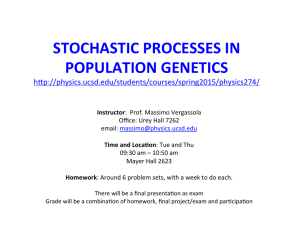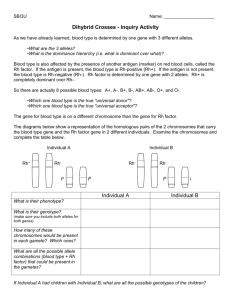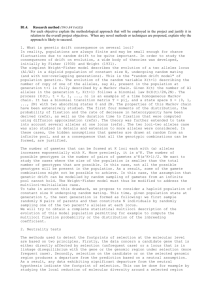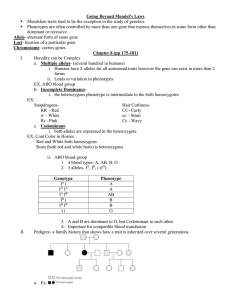Document 11743577
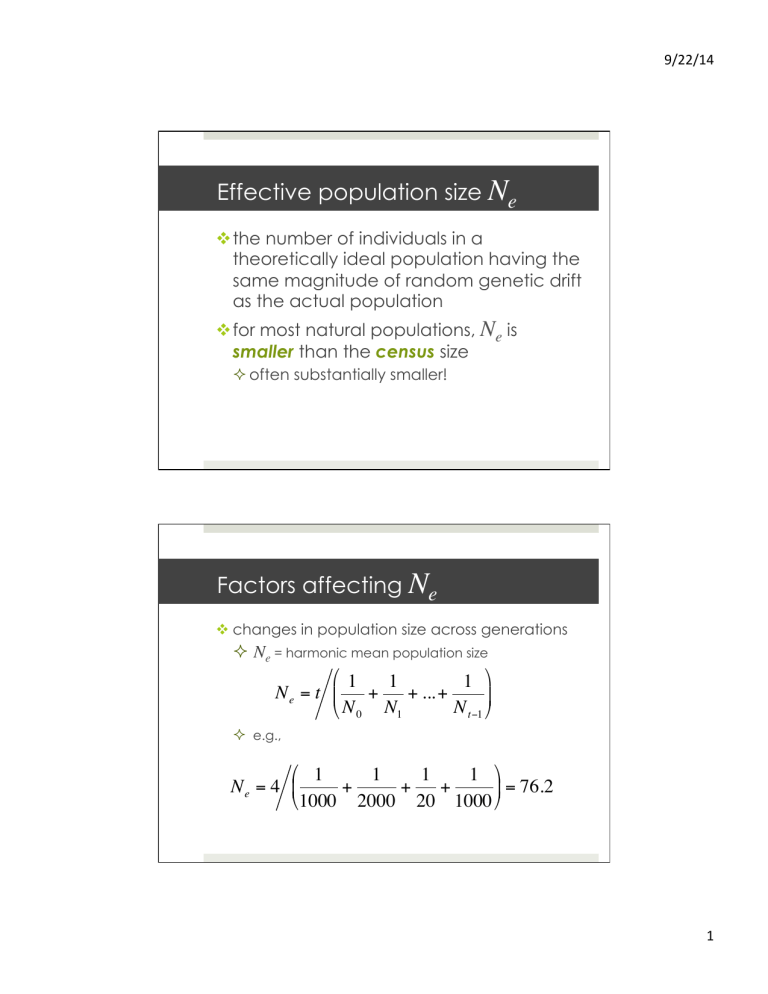
9/22/14
Effective population size N e v the number of individuals in a theoretically ideal population having the same magnitude of random genetic drift as the actual population v for most natural populations, smaller than the census size
N e
is
² often substantially smaller!
€
Factors affecting N e v changes in population size across generations
² N e
= harmonic mean population size
N e
= t
#
%
$ N
1
0
+
1
N
1
+ ...
+
1
N t − 1
&
(
'
² e.g.,
€
N e
= 4
"
$
#
1
1000
+
1
2000
+
1
20
+
1
1000
%
'
= 76.2
&
1
Factors affecting N e v sex ratio (of breeding individuals)
² “ bottleneck ” through the less numerous sex
N e
N
= 4
N m m
+
N
N f f
² e.g.,
N e
= 4
×
10
×
100
10 + 100
= 36.4
Factors affecting N e v variation in “family size” (i.e., fitness)
²
What is N e
in a haploid population in which every individual leaves one offspring?
² Diploid?
N e
=
4 N t − 1 var( k ) + k 2
−
k
² where k is family size for a pair of diploid individuals
² what is k for a stable population?
² poisson distribution: mean = variance
9/22/14
2
9/22/14
Factors affecting N e v sex chromosomes
² the “ population ” size of sex chromosomes is smaller than for autosomes
² N e
for X-linked genes:
N e
=
4
9 N m
N
N m
+ 2 f
N f
² if N m
= N f
, then N e
€
= 3 N /4
² mtDNA and Y-chromosome and females
N e
=
N /4
² assuming equal variance in RS between males
3
N = 1000; at time 0, A1 = A2 = 0.5; mt ; nuc
1
0.9
0.8
0.7
0.6
0.5
0.4
0.3
0.2
0.1
0
1 12 23 34 45 56 67 78 89 100 111 122 133 144 155 166 177 188 199 number of generations x 10
606 trials
140
120
100
80
60
40
20 mt nuc
0
100 200 300 400 500 600 700 800 900 1000 1100 1200 1300 1400 1500 1600 1700 1800 1900 2000 2100
2000+ generations number of generations to fixation
N = 1000; at time 0, A1 = A2 = 0.5
9/22/14
4
Factors affecting N e v population structure with gene flow
² population subdivision maintains relatively greater genetic diversity (slows the process of drift to fixation in the overall population)
N e
= ND
!
1+
"
1
4 Nm
$
&
%
² …where N is the population size in each of D demes and demes m is the migration rate between
Factors affecting N e v breeding sex ratio v fluctuation in population size v variance in family size (or # offspring) v number of gene copies
² sex chromosomes, mtDNA v population structure
9/22/14
5
Fig. 3.4 Random genetic drift in 107 Drosophila populations; 8 males, 8 females each generation
Why different from ideal expectations
?
9/22/14
“ Identical by Descent ” v concept used to derive theoretical expectations for N e v Hartl & Clark develop the concept using a structured population model (Fig. 3.9)
6
v Fig. 3.9
Overall average allele frequency stays the same but heterozygosity declines
Fig. 3.5 Predicted distributions of allele frequencies in replicate populations of N = 16
Fig. 3.9 (last slide) is showing the exact same process as this figure
9/22/14
7
9/22/14
“ Identical by Descent ” v what is the probability that two randomly sampled alleles are identical by descent (i.e.,
“ replicas of a gene present in a previous generation ” )?
² Wright ’ s “ fixation index ” F v at the start of the process (time 0), “ declare ” all alleles in the population to be unique or unrelated, F t
= 0 at t = 0 v in the next generation, the probability of two randomly sampled alleles being copies of the same allele from a single parent = 1/(2 N ) , so…
“ Identical by Descent ”
€
F t
=
1
2 N
+
#
%
$
1
−
1
2 N
&
(
F
'
t − 1 or
F t
#
= 1- 1
$
−
1
2 N
&
(
'
t
€
8
“ Identical by Descent ”
F t
=
1
2 N
+
#
%
$
1
−
1
2 N
&
(
F
'
t − 1
= probability that alleles are copies of the same gene from the immediately preceding generation plus the probability that the alleles are copies of the same gene from an earlier
€
or
F t
#
= 1- 1
$
−
1
2 N
&
(
'
t assuming F
0
= 0
€
compare to: mean time to fixation for new mutant =
~4 N
9/22/14
9
Random genetic drift in 107 Drosophila populations;
8 males, 8 females each generation
9/22/14
H t
=
"
$
#
1
−
1
2 N e
%
'
&
t
H
0
≈
H
0 e
− t
2 N e
10
Deriving the population size effect
v
Start here:
F t
1
=
2 N
+
#
%
$
1
−
1
2 N
&
(
F
'
t − 1 v
Finish here: v
€
N e
= t
$
#
%
N e
N
1
0
+
1
N
1
+ ...
+
N
1 t − 1
(
'
&
are similarly based on the logic of identity by descent
(Hartl & Clark: pp. 116-122)
€
9/22/14
11


